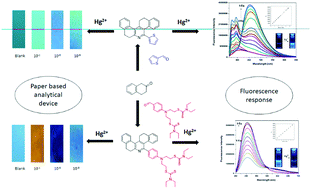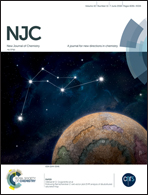Development of paper-based chemosensor for the detection of mercury ions using mono- and tetra-sulfur bearing phenanthridines†
Abstract
A new and simple fluorescent probe bearing mono-sulfur (1) and tetra-sulfur (2) tetrahydrodibenzo phenanthridine derivatives were synthesized and examined for their cation recognition abilities towards different cations in aqueous acetonitrile solution and paper strips. Both the probes showed high selectivity and sensitivity with strong affinity towards Hg2+ ions over other cations, such as Cu2+, Ca2+, Co2+, Cd2+, Pb2+, Zn2+, Ni2+, Mg2+, Mn2+, Al3+, Fe3+, La3+, Ag+, K+, Na+ and Li+. The binding stoichiometry ratios of 1–Hg2+ and 2–Hg2+ are recognized as 1 : 1 according to the UV-Vis absorption spectra, fluorescence measurements and computational (DFT) studies, and the possible binding mode of these receptors with Hg2+ is also proposed. The limit of detection with Hg2+ cation was found to be as low as 0.91 nM and 0.041 nM for probes 1 and 2, respectively. The results clearly indicate that the synthesised tetrahydrodibenzo phenanthridine derivatives 1 and 2 could be used as excellent chemosensors for Hg2+ detection in biological and environmental samples.



 Please wait while we load your content...
Please wait while we load your content...